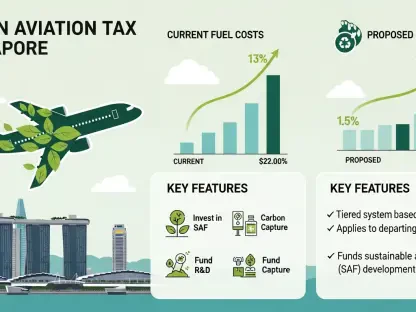Imagine a world where the U.S. dollar’s reign over global trade faces a formidable rival in the form of a digital Chinese yuan powering energy markets across Central Asia. At the recent Shanghai Cooperation Organisation (SCO) summit in Tianjin, China, President Xi Jinping unveiled ambitious plans to reshape economic dynamics through renewable energy corridors and yuan-based trade settlements. This roundup dives into diverse opinions, analyses, and insights from various global sources and industry voices to unpack the implications of this bold strategy. The purpose is to explore how Xi’s vision challenges Western financial dominance and what it means for the future of international economics and energy trade.
Central AsiThe New Economic Battleground
Central Asia has emerged as a pivotal region in global geopolitics, and the SCO summit served as a platform for China to cement its influence. Many industry observers note that the region’s vast resources and strategic location make it a critical chessboard for economic supremacy. Analysts from international think tanks emphasize that China’s focus on deepening ties with countries like Kazakhstan and Uzbekistan is a calculated move to counterbalance Western economic structures, particularly through energy and trade partnerships.
A contrasting perspective comes from economic strategists who caution that while Central Asia offers immense potential, political instability and infrastructural gaps could hinder rapid progress. Some sources highlight the significant trade growth, with bilateral exchanges between China and Central Asian nations hitting record highs recently, driven by exports of machinery and electric vehicles. This data fuels optimism among pro-China commentators who see the region as ripe for transformation under Beijing’s guidance.
Yet, skepticism persists among Western financial analysts who argue that China’s aggressive push might alienate other regional players or provoke backlash from global powers. They point out that while economic integration sounds promising, the cultural and historical complexities of Central Asia could pose unforeseen challenges to China’s overarching plans. This diversity of views sets the stage for a deeper exploration of specific initiatives unveiled at the summit.
Unpacking China’s Strategic Economic Moves
Green Energy Corridors: Redefining Regional Power Dynamics
China’s emphasis on renewable energy in Central Asia has garnered significant attention, with many energy sector insiders viewing it as a cornerstone of Xi’s broader economic strategy. Reports suggest that investments in solar and wind projects, particularly in nations with expansive landscapes like Kazakhstan, are already underway, backed by major Chinese firms. These initiatives aim to create a green energy corridor that could supply affordable electricity to markets as far as Europe and Southeast Asia.
However, opinions diverge on the practicality of such ambitious infrastructure. Some energy consultants express enthusiasm for the potential to revolutionize power distribution, citing the urgent global shift toward sustainable sources. They argue that if successful, this corridor could position China as a leader in the renewable energy space, altering traditional energy trade routes.
On the other hand, logistical experts raise concerns about the feasibility of transmitting electricity over vast distances, pointing to technical challenges and high costs. Resistance from Western energy stakeholders, who may view this as a threat to their market share, is also a recurring theme in discussions. These differing viewpoints underscore the complexity of turning green energy visions into tangible outcomes.
Electro-Yuan: A New Currency for Energy Trade
The concept of using the yuan for energy trade settlements, often dubbed the “electro-yuan,” has sparked intense debate among financial analysts. Many see parallels to the petrodollar system that solidified U.S. financial hegemony decades ago, with some commentators suggesting that China’s early steps—such as a notable wind power deal in Uzbekistan settled in renminbi—signal a serious intent to challenge the dollar’s dominance. This shift is seen as particularly timely given the rising demand for electricity driven by electric vehicles and AI technologies.
Contrarily, a segment of currency market watchers remains doubtful about global adoption of the yuan in such a capacity. They argue that trust in the Chinese currency lags behind the dollar due to concerns over transparency and government control. This skepticism is balanced by others who believe that incremental progress in regional trade agreements could gradually build confidence in yuan-based transactions.
Geopolitical implications also feature prominently in discussions. Some sources warn that pushing for the electro-yuan risks escalating tensions with Western economies, potentially leading to trade barriers or sanctions. This mix of optimism and caution illustrates the high stakes involved in redefining global financial norms through energy trade.
SCO Development Bank: Financial Leverage for the Global South
Xi’s proposal for an SCO development bank, supported by substantial aid commitments, has been met with a spectrum of reactions. Proponents, including regional economic forums, view this as a vital step toward tightening economic bonds with Central Asian nations, offering an alternative to Western-led institutions like the IMF. They highlight the potential for tailored financial solutions that address the unique needs of SCO member states.
Critics, however, question the long-term viability of such a bank, pointing to disparities among member countries and the challenge of aligning diverse economic priorities. Some financial analysts suggest that without robust governance and transparency, the initiative risks becoming a tool for China’s unilateral influence rather than a true multilateral effort.
A third perspective comes from development experts who see this as a testing ground for shifting financial influence eastward. They argue that even partial success could inspire similar models in other regions of the Global South, though they acknowledge the steep hurdles in rivaling established global financial systems. This range of opinions reflects the uncertainty surrounding this ambitious financial pivot.
Geopolitical Strategy: A Challenge to Western Dominance
The broader geopolitical ramifications of China’s Central Asian strategy are a hot topic among international relations scholars. Many agree that Xi’s vision aligns with a push for a multilateral economic order that prioritizes the Global South, directly challenging U.S.-centric frameworks. This perspective is bolstered by historical comparisons to past shifts in currency dominance, with some suggesting that a yuan-driven energy trade could be transformative.
Others, however, caution against overestimating the immediate impact, noting that international trust in the yuan remains a significant barrier. Western policy analysts often frame this as a high-risk gambit, warning that geopolitical tensions could derail progress if not managed carefully. They stress the need for China to build broader alliances to legitimize its currency on the global stage.
A more nuanced take comes from think tanks focused on global economics, which argue that while the vision is compelling, systemic barriers and entrenched dollar dominance will likely slow any major shift. These varied insights paint a picture of a strategic but challenging endeavor to undermine Western hegemony, with outcomes that remain far from certain.
Key Takeaways from Diverse Voices
Synthesizing the array of opinions, China’s push at the SCO summit stands out for its focus on renewable energy projects, yuan-based trade settlements, and financial integration through a proposed development bank. Energy commentators largely agree on the transformative potential of green corridors, though logistical hurdles are a common concern. Financial analysts are split on the electro-yuan’s prospects, with some seeing it as a future rival to the dollar while others doubt its global appeal.
On the geopolitical front, there is consensus that China’s moves are a direct challenge to Western economic control, but the degree of success is debated. Some sources stress the importance of regional stability and trust-building for these initiatives to gain traction, while others predict resistance from established powers. This spectrum of thought highlights the multifaceted nature of Xi’s strategy and its global implications.
For policymakers and businesses, monitoring the adoption of the yuan in energy contracts offers a practical way to gauge progress. Engaging in partnerships within Central Asia could also provide firsthand insights into China’s expanding influence. Staying informed through trade data analysis and tracking SCO developments remains essential for understanding this evolving economic landscape.
Reflecting on a Pivotal Moment
Looking back, the discussions surrounding Xi’s initiatives at the SCO summit revealed a complex interplay of ambition and uncertainty among global observers. The diverse perspectives underscored both the potential for significant shifts in energy and financial systems and the formidable challenges that lie ahead. Each viewpoint contributed to a richer understanding of how Central Asia became a focal point in this economic chess game.
Moving forward, stakeholders are encouraged to delve deeper into regional trade agreements and energy project outcomes as indicators of China’s success. Exploring collaborative opportunities with SCO nations emerges as a strategic step for those aiming to navigate this changing terrain. Keeping an eye on geopolitical responses also proves crucial, as they could shape the trajectory of these bold initiatives in unexpected ways.









